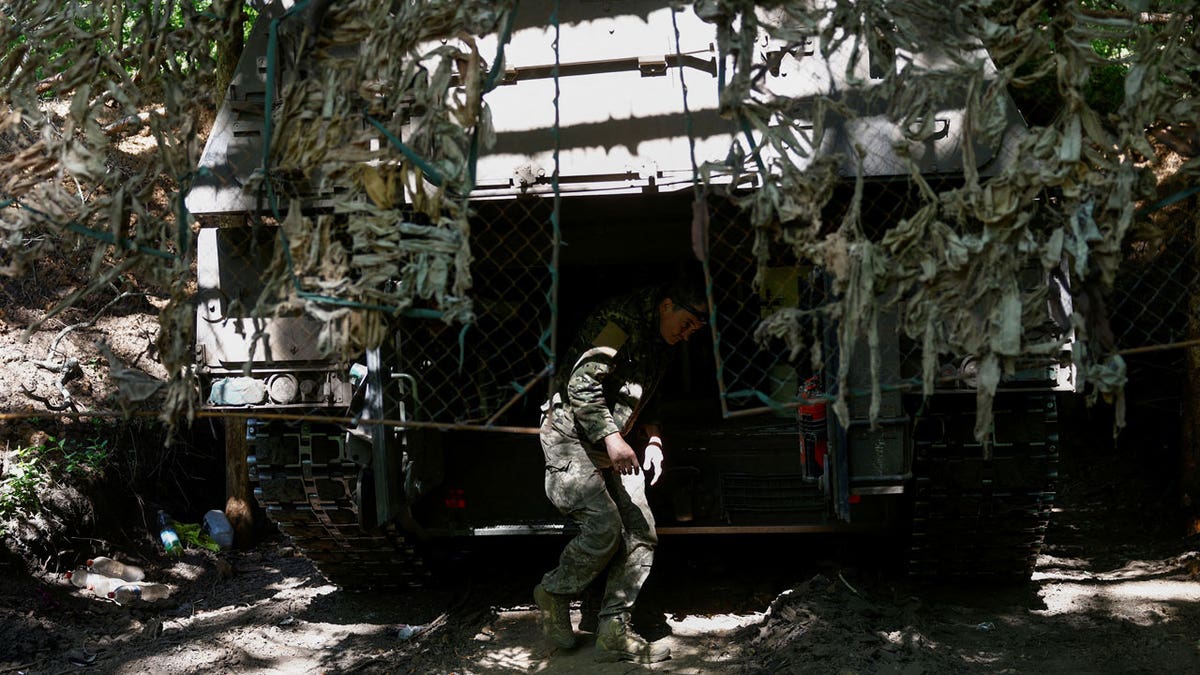Rumbling out of its forest hideout, the hulking German-supplied howitzer has only a few minutes to fire before slipping back under cover to evade Russian surveillance in the skies above.
Across the hills and valleys of the east, Ukrainian artillery units play a cat-and-mouse game with Russian drones hunting high-value artillery weapons such as this self-propelled Panzerhaubitze 2000.
Moscow’s troops have stepped up ground attacks along the 621-mile front in the south and east of Ukraine, threatening some of the industrialized Donetsk region’s last big cities held by Kyiv more than two years after Russia’s full-scale invasion.
UKRAINE EXAMINES NORTH KOREA MISSILE DEBRIS FROM RUSSIAN STRIKES
Counterbattery efforts are crucial to suppressing enemy fire that rains on Ukrainian lines and artillery units, and paves the way for Russian advances.
Crews including the one Reuters recently visited, part of the 43rd Artillery Brigade, say they face increasing harassment from enemy drones that have become a staple of Russia’s arsenal.
“There were (attacks) before, but not the same amount,” said battery commander “Lyova”, 27, using his call sign. “Now it’s really scary.”

Ihor, Ukrainian serviceman of the 43rd Separate Artillery Brigade, walks next to a Panzerhaubitze 2000 self-propelled howitzer after firing toward Russian troops amid Russia’s attack on Ukraine, in the Donetsk region, Ukraine, May 4, 2024. (Reuters/Valentyn Ogirenko/File Photo)
Lyova, who is from western Ukraine, said his unit had been directly hit four times by Russian high-tech Lancet attack drones. Crew members remained largely unharmed thanks to the Panzerhaubitze’s armor.
Russian reconnaissance drones such as the Orlan or the more advanced Supercam are a particular nuisance, said senior battery officer Andriy Stavnychyi.
“Sometimes it happens that there’s lots of work for the day, but we can’t move because something is always flying above,” Stavnychyi, 31, told Reuters during a visit to the unit’s underground command post.
Enemy surveillance drones often pose a greater risk to Ukrainian artillery units than Russian counterbattery radar, according to Rob Lee, a senior fellow at the Foreign Policy Research Institute (FPRI).
The Panzerhaubitze rotates among multiple hiding spots around the unit’s position, which the Ukrainian military requested not be disclosed. They are nestled deep in tree cover and feature hand-built wooden frames that shroud the vehicle.
PRIME TARGETS
Stavnychyi echoed other Ukrainian troops and senior officials who have called for more electronic warfare systems to jam Russian drones.
Western-supplied artillery such as the Panzerhaubitze is a priority target for Moscow, which has pledged to focus its strikes on such weapons.
Battery commander Lyova said Russian forces have at times piled pressure on their unit, including through the laser-guided Krasnopol artillery system that eventually struck one of the hideouts. It was not critically damaged.
“Before that, they fired around 50 (standard) shells throughout a day and a half, but couldn’t hit it,” he said.
Russian Defense Minister Sergei Shoigu said last month Moscow would intensify strikes on Ukrainian storage bases that house Western-supplied weapons.
Lee, the FPRI expert, said weakened Ukrainian counterbattery capabilities meant Russian forces “can be more aggressive about how they employ artillery.”
“They can move it closer, they don’t have to necessarily change positions that often,” he said.
Like other Ukrainian artillery units, the 43rd Brigade battery faces a critical shell shortage that limits the Panzerhaubitze’s potential.
Ukrainian troops across the sprawling front are anxiously awaiting shipments from a long-delayed $61-billion U.S. military aid package.
The Panzerhaubitze gunners said they lacked the proprietary 155mm shells designed to maximize its efficiency and range of around 40 km.
Longer-range ammunition would allow them to target analogous Russian self-propelled guns far behind the front line, and keep them further back to protect from Russian counterbattery fire.
Although well-supplied during a failed Ukrainian counteroffensive last year, Lyova’s unit now fires far fewer shells per day – only between eight and 15, he estimated.
Repairing the vehicle is also a challenge, with availability of spare parts limited and a navigation system that frequently malfunctions but is difficult to fix on the battlefield.
CLICK HERE TO GET THE FOX NEWS APP
Stavnychyi, the senior officer, said some parts could be swapped among the Italian and Dutch artillery pieces also under his command.
“But even if there were parts and shells, you’d have the problem of enemy ‘birds’,” he said, referring to drones.
“So everything needs to work together in a system: electronic warfare and surveillance, (and) artillery. Then our hit percentage would be much higher.”
